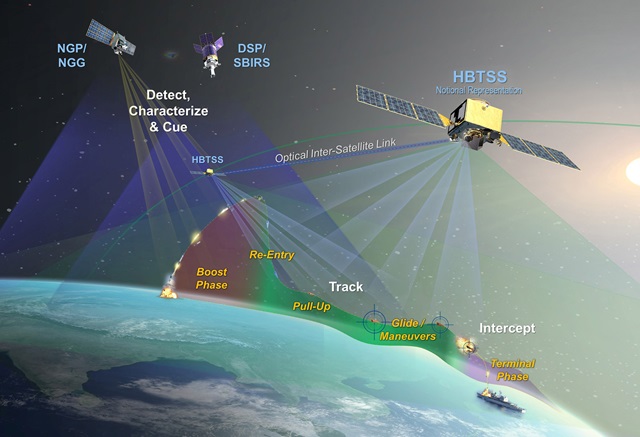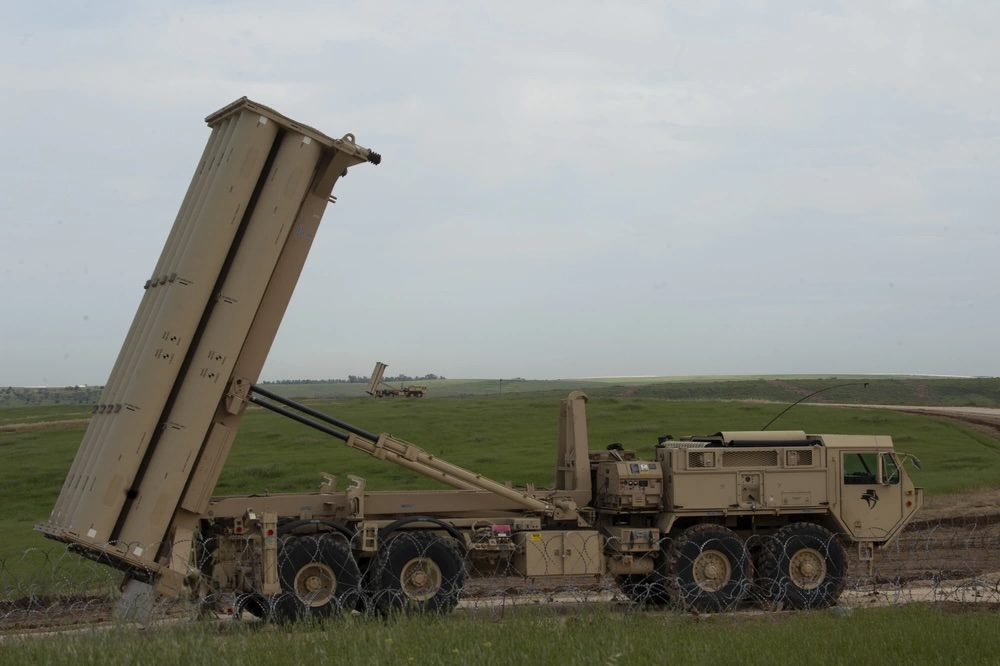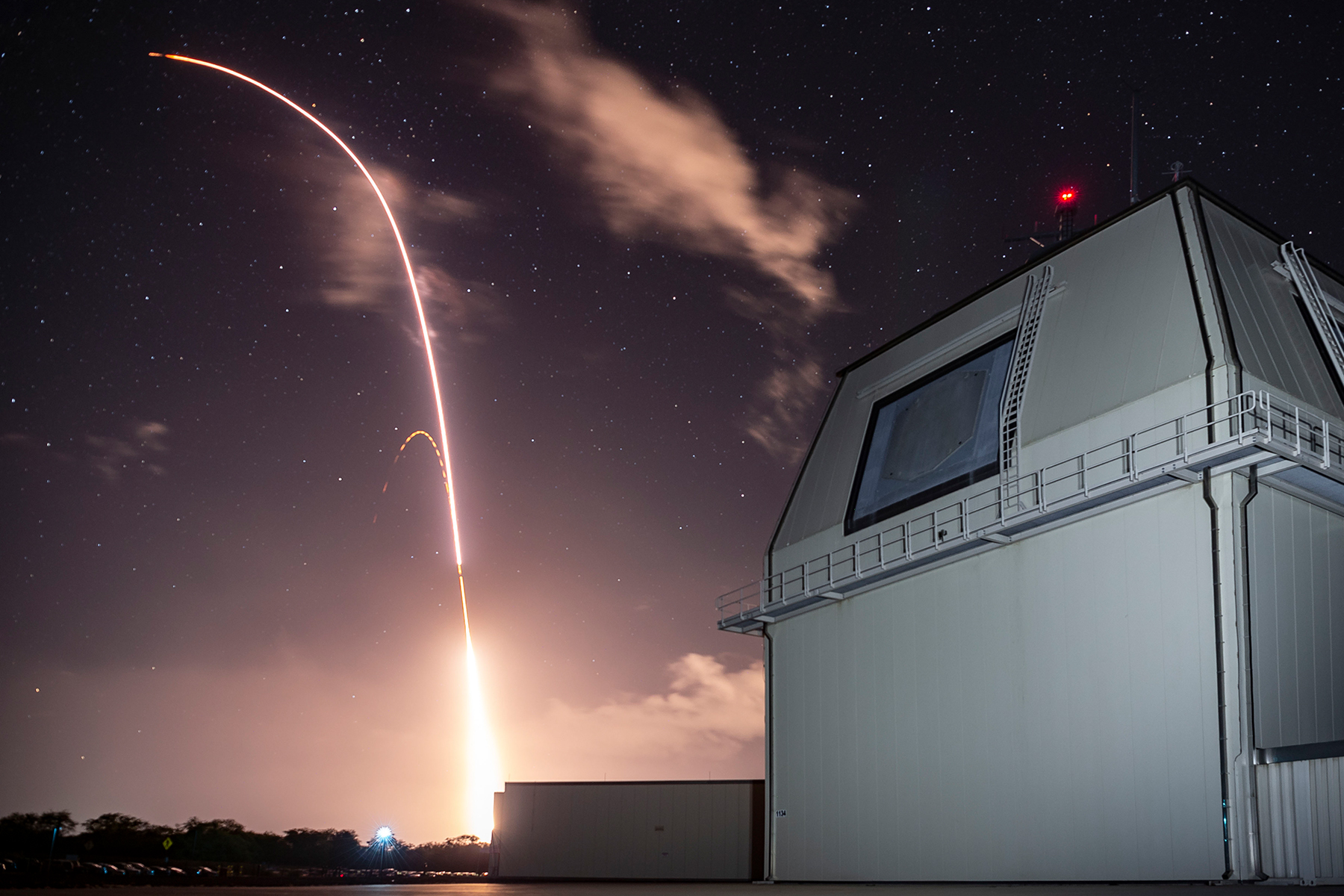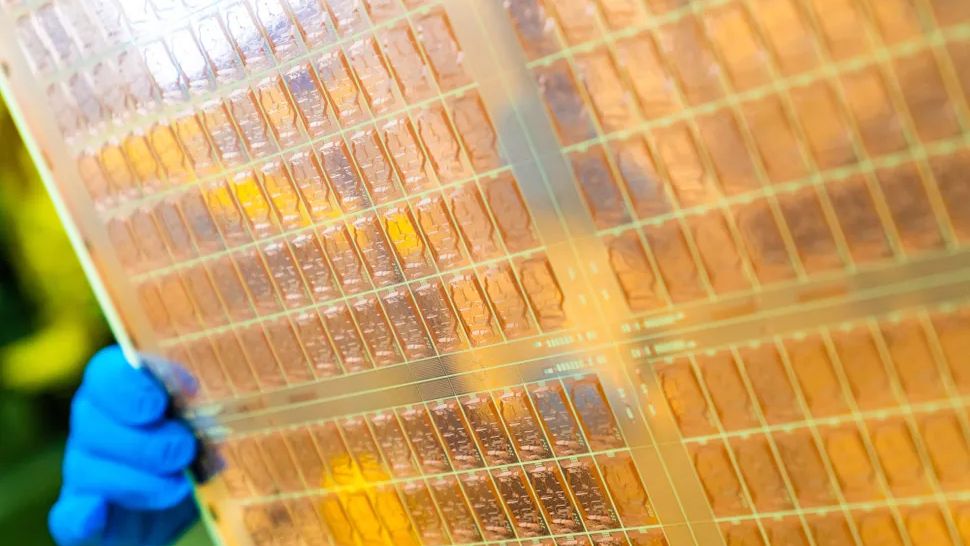"Basically, I've been given 60 days to come up with the objective architecture."
Gen. Michael Guetlein, overseeing the development of the Golden Dome missile defense system, looks on as President Donald Trump speaks in the Oval Office of the White House on May 20, 2025, in Washington, DC. Credit: Jim Watson/AFP via Getty Images
The newly installed head of the Pentagon's Golden Dome missile defense shield, a monumental undertaking projected to cost $175 billion over the next three years, knows the clock is ticking to show President Donald Trump some results before the end of his term in the White House.
"We are going to try to craft a schedule to have incremental demonstrations every six months because we are on a short timeline," said Gen. Michael Guetlein, who was confirmed by the Senate last week to become the military's Golden Dome czar.
Speaking on Tuesday, his second day on the job leading the Golden Dome initiative, Guetlein said his team will "move out with a sense of urgency and move out with incremental wins" as the military races to meet Trump's timeline.
Guetlein discussed his new job with retired Gen. John "Jay" Raymond, the first chief of the Space Force, at an event in Washington, DC, hosted by the Space Foundation.
Analysts and retired military officials doubt the Pentagon can achieve all of Trump's Golden Dome promises by the end of 2028. It's not yet clear what the Pentagon can finish in three years, but Guetlein said Thursday his team will deliver "a capability" on that schedule. "We've got to exploit anything and everything we've possibly got," he said, echoing a tenet of Space Force policy to "exploit what we have, buy what we can, and build what we must."
This means the Space Force will lean heavily on commercial companies, research labs, academia, and, in the case of Canada, international partners to build the Golden Dome.
"Golden Dome for America requires a whole-of-nation response to deter and, if necessary, to defeat attacks against the United States," the Defense Department said in a statement Tuesday. "We have the technological foundation, national talent, and decisive leadership to advance our nation's defenses. We are proud to stand behind Gen. Mike Guetlein as he takes the helm of this national imperative."
President Trump signed an executive order in January calling for the development of a layered missile defense shield to protect the US homeland. He initially called the project the Iron Dome for America, named for Israel's Iron Dome missile defense system. But Israel's Iron Dome, which has proven effective against missile attacks from Iran and its proxies in the Middle East, only has to defend an area the size of New Jersey. The Pentagon's system, now named Golden Dome, will ostensibly cover the entire United States.
Lay of the land
Advocates for the Golden Dome point to recent events to justify the program. These include Russia's first use of an intermediate-range ballistic missile against Ukraine last year, and Ukraine's successful drone attack on a Russian airbase last month. Waves of Iranian missile and drone attacks on Israel have tested the mettle of that country's Iron Dome.
In the January 27 executive order, the White House said the military's plan must defend against many types of aerial threats, including ballistic, hypersonic, and advanced cruise missiles, plus "other next-generation aerial attacks," a category that appears to include drones and shorter-range unguided missiles.
This will require a network of sensors on the ground and in space, including heat-seeking sensors and radars to track incoming aerial threats, and interceptors based on the ground, at sea, and in space capable of destroying missiles at any point in flight—boost phase, midcourse, and during final approach to a target.

This illustration shows how the Missile Defense Agency's HBTSS satellites can track hypersonic missiles as they glide and maneuver through the atmosphere, evading detection by conventional missile-tracking spacecraft, such as the Space Force's DSP and SBIRS satellites. Credit: Northrop Grumman
The good news for backers of the Golden Dome program is that the Pentagon and commercial industry were developing most of these elements before Trump's executive order. The Space Development Agency (SDA) launched a batch of prototype missile-tracking and data-relay satellites in 2023, pathfinders for a constellation of hundreds of spacecraft in low-Earth orbit that will begin launching later this year.
In some cases, the military has already fielded Golden Dome components in combat. The Army has operated the Patriot missile system since the 1980s and the Terminal High Altitude Area Defense (THAAD) interceptors for more than 15 years to defend against lower-level threats like small rockets, aircraft, and drones. The Navy's Aegis Ballistic Missile Defense System uses sea-launched interceptors to target longer-range missiles in space.
The Missile Defense Agency manages the Ground-based Midcourse Defense (GMD) program, which consists of operational silo-launched missile interceptors based in Alaska and California that could be used to defend against a limited missile strike from a rogue state like North Korea.
GMD has cost approximately $70 billion to date and has worked a little more than half the time the military has tested it against a missile target. On the plus side, GMD has achieved four straight successful intercepts in tests since 2014. But despite its immense cost, GMD is antiquated and would not be effective against a large volley of missiles coming from another nuclear superpower, like China.
Golden Dome will bring all of these systems together, and add more to the mix in order to "double down on the protection of the homeland and protect our American citizens," Guetlein said.
What’s next?
Guetlein identified several short-term priorities for what is officially called the "Office of Golden Dome for America." One of them is to begin bringing together the military's existing missile detection and tracking assets, ground- and sea-based interceptors, and the communication pathways, or "comm pipes," to connect all the pieces in a sophisticated command-and-control network.
"That includes the sensors, that includes the shooters, as well as the comm pipes," Guetlein said. "How do we bring all that to bear simultaneously in protection of the homeland, while utilizing the capabilities that are already there and not trying to re-create them?"
The Pentagon said in a statement Tuesday that Guetlein's office will devise an "objective architecture" for the missile defense shield and "socialize" it by late September. This presumably means sharing some information about the architecture with Congress and the public. So far, Space Force officials have hesitated to provide any specifics, at least in public statements and congressional hearings. They often prefer to describe Golden Dome as a "system of systems" instead of something entirely new.
"Basically, I've been given 60 days to come up with the objective architecture. I owe that back to the Deputy Secretary of Defense in 60 days," Guetlein said. "So, in 60 days, I'll be able to talk in depth about, 'Hey, this is our vision for what we want to get after for Golden Dome.'"
Although the major pieces of a layered anti-missile system like Golden Dome may appear obvious to anyone with a casual familiarity with missile defense and space—we just named a few of these elements above—the Trump administration has not published any document describing what the Pentagon might actually achieve in the next three years.
Despite the lack of detail, Congress voted to approve $25 billion as a down payment for Golden Dome in the Trump-backed "One Big Beautiful Bill" signed into law July 4. The bulk of the Golden Dome-related budget is earmarked for procurement of more Patriot and THAAD missile batteries, an increase in funding for SDA's missile-tracking satellites, ballistic missile defense command-and-control networks, and development of "long-range kill chains" for combat targeting.

Two of the US Army's THAAD missile batteries are seen deployed in Israel in this 2019 photo. Credit: US Army/Staff Sgt. Cory Payne
So, most of the funding allocated to Golden Dome over the next year will go toward bolstering programs already in the Pentagon's portfolio. But the military will tie them all together with an integrated command-and-control system that can sense an adversarial missile launch, plot its trajectory, and then generate a targeting solution and send it to an interceptor on the ground or in space to eliminate the threat.
Eventually, military leaders want satellites to handle all of these tasks autonomously in space and do it fast enough for US or allied forces to respond to an imminent threat.
"We know how to get data," a retired senior military official recently told Ars. "The question is, how do you fuse that data in real time with the characteristics of a fire control system, which means real-time feedback of all this data, filtering that data, filtering out sensors that aren't helping as much as other ones, and then using that to actually command and control against a large-scale attack of diverse threats.
"I feel like those are still two different things," said the official, who spoke on background with Ars. "It's one thing to have all the data and be able to process it. It's another thing to be able to put it into an active, real-time fire control system."
Trump introduced Guetlein, the Space Force's former vice chief of space operations, as his nominee for director of the Golden Dome program in an Oval Office event on May 20. At the time, Trump announced the government had "officially selected an architecture" for Golden Dome. That appears to still be the work in front of Guetlein and his team, which is set to grow with new hiring but will remain "small and flat," the general said Tuesday.
Guetlein has a compelling résumé to lead Golden Dome. Before becoming the second-ranking officer in the Space Force, he served as head of Space Systems Command, which is responsible for most of the service's acquisition and procurement activities. His prior assignments included stints as deputy director of the National Reconnaissance Office, program executive at the Missile Defense Agency, program manager for the military's missile warning satellites, and corporate fellow at SpaceX.
Weapons in space
Guetlein identified command and control and the development of space-based interceptors as two of the most pressing technical challenges for Golden Dome. He believes the command-and-control problem can be "overcome in pretty short order."
"I think the real technical challenge will be building the space-based interceptor," Guetlein said. "That technology exists. I believe we have proven every element of the physics that we can make it work. What we have not proven is, first, can I do it economically, and then second, can I do it at scale? Can I build enough satellites to get after the threat? Can I expand the industrial base fast enough to build those satellites? Do I have enough raw materials, etc.?"
This is the challenge that ultimately killed the Strategic Defense Initiative (SDI) or "Star Wars" program proposed by former President Ronald Reagan in the 1980s as a way to counter the threat of a nuclear missile attack from the Soviet Union. The first concept for SDI called for 10,000 interceptors to be launched into Earth orbit. This was pared down to 4,600, then finally to fewer than 1,000 before the cancellation of the space-based element in 1993.
Thirty years ago, the United States lacked the technology and industrial capacity to build and launch so many satellites. It's a different story today. SpaceX has launched more than 9,000 Starlink communications satellites in six years, and Amazon recently kicked off the deployment of more than 3,200 Internet satellites of its own.
Space-based interceptors are a key tenet of Trump's executive order on Golden Dome. Specifically, the order calls for space-based interceptors capable of striking a ballistic missile during its boost phase shortly after launch. These interceptors would essentially be small satellites positioned in low-Earth orbit, likely a few hundred miles above the planet, circling the world every 90 minutes ready for commands to prevent nuclear Armageddon.

A Standard Missile 3 Block IIA launches from the Aegis Ashore Missile Defense Test Complex at the Pacific Missile Range Facility in Kauai, Hawaii, on December 10, 2018, during a test to intercept an intermediate-range ballistic missile target in space. Credit: Mark Wright/DOD
Reuters reported Tuesday that the Defense Department, which reportedly favored SpaceX to play a central role in Golden Dome, is now looking to other companies, including Amazon Kuiper and other big defense contractors. SpaceX founder Elon Musk has fallen out of favor with the Trump administration, but the company's production line continues to churn out spacecraft for the National Reconnaissance Office's global constellation of spy satellites. And it's clear the cheapest and most reliable way to launch Golden Dome interceptors into orbit will be using SpaceX's Falcon 9 rocket.
How many space-based interceptors?
"I would envision that there would be certainly more than 1,000 of those in orbit in different orbital planes," said retired Air Force Gen. Henry "Trey" Obering III, a senior executive advisor at Booz Allen Hamilton and former commander of the Missile Defense Agency. "You could optimize those orbital planes against the Russian threat or Chinese threat, or both, or all the above, between Iran, North Korea, China, and Russia."
In an interview with Ars, Obering suggested the interceptors could be modest in size and mass, somewhat smaller than SpaceX's Starlink satellites, and could launch 100 or 200 at a time on a rocket like SpaceX's Falcon 9. None of this capability existed in the Reagan era.
Taking all of that into account, it's understandable why Guetlein and others believe Golden Dome is doable.
But major questions remain unanswered about its ultimate cost and the realism of Trump's three-year schedule. Some former defense officials have questioned the technical viability of using space-based interceptors to target a missile during its boost phase, within the first few minutes of launch.
It's true that there are also real emerging threats, such as hypersonic missiles and drones, that the US military is currently ill-equipped to defend against.
"The strategic threats are diversifying, and then the actors are diversifying," the former military space official told Ars. "It's no longer just Russia. It's China now, and to a lesser extent, North Korea and potentially Iran. We'll see where that goes. So, when you put that all together, our ability to deter and convince a potential adversary, or at least make them really uncertain about how successful they could be with a strike, is degraded compared to what it used to be."
The official said the Trump administration teed up the Golden Dome executive order without adequately explaining the reasons for it. That's a political failing that could come back to bite the program. The lack of clarity didn't stop Congress from approving this year's $25 billion down payment, but there are more key decision points ahead.
"I'm a little disappointed no one's really defined the problem very well," the retired military official said. "It definitely started out as a solution without a problem statement, like, 'I need an Iron Dome, just like Israel.' But I feel like the entire effort would benefit from a better problem statement."









 English (US) ·
English (US) ·